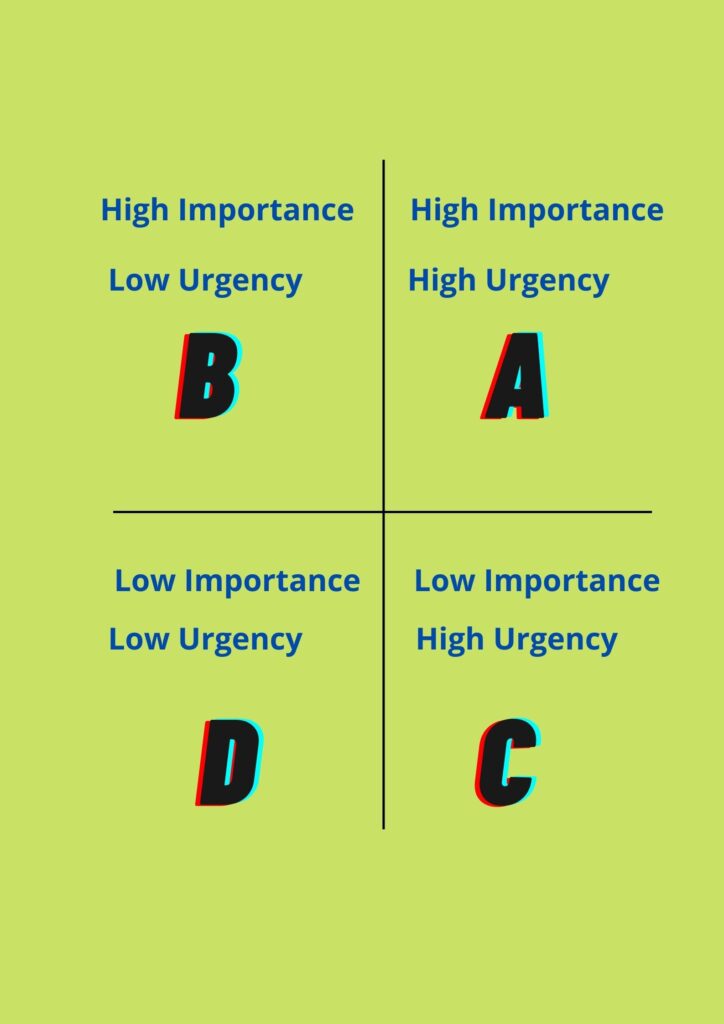7 Time Management tips to manage tasks efficiently
Why is it that some people are more successful while others are not? All of us get 24 hours a day, but still, some get a lot of work done in the same 24 hours while others are overwhelmed by their work and end their day frustrated, leaving most of the significant tasks incomplete. Though all of them are working, successful people follow some time management techniques that help them use the time effectively.
You will get good results if you follow the same time management strategies. I am listing 7 practical time management tips that will help students and professionals manage their time efficiently.
1. Brain-dump – Create a TODO list
The first thing you need to do is to write down all the tasks you can think of. Keeping everything in your brain will reduce the working power of your brain. Your brain is for creative work and not just storing information. You have to free up your brain by brain-dumping. Just imagine that you have a table dumped with 100s of books and papers.

Can you organize the table without using additional space to free up some space? You can use a traditional process by writing on a piece of paper or a digital medium like mobile, computer or tablet.
It does not matter which mode of documenting your to-do list you choose. You have to ensure that you are freeing up your brain for creative thinking and not to use the brain as a storage device.
There are a lot of free tools available in the market, and some of them are really good for managing your task. I use Asana and it helped me a lot. The free version is good enough, and the paid version is more powerful.
There are a few other tools like Trello, and Microsoft To Do, but I have yet to use them. Updating the TODO list is an ongoing process. Anytime you think of any task, jot it down and relieve your brain from the burden of storing this essential information.
Thus, you will have all your tasks written somewhere without worrying about forgetting any necessary tasks. You can use your brain to do creative thinking.
2. Document your goals
Goals can be compared to a destination of a traveler. A traveler can only find the correct route map if fixing the destination. Similarly, fixing your goal is necessary to determine which task to do and what not. Here comes the importance of documenting your goals.
It can be documented in plain paper or some digital medium. Categorize your goals into 3 broad categories:
- Personal and Family Goals
- Business and Financial Goals
- Self-Development goals
There can be more categories applicable for some of you.
We will discuss each of these in detail in some other place. For now, consider your long-term goal, which can be more than one, but they will most likely come under these categories. Write down your goals and review them every 2-3 days so that you stay aligned with our goal. Your goal can change with time, and editing your goal is fine.
3. Prioritize your list
Now you have a list of tasks to do and some goals in front of you. You have to find out which of these tasks map to the goals you have defined. You need to ensure those tasks that will take you towards accomplishing your goal are given the highest importance. This is because these tasks can help you achieve your goals.
Your tasks should be categorized by 2 vital parameters – importance and urgency.
Importance denotes how much impact the task can have on your life, and urgency indicates how immediately it needs to be done. Some tasks can be of low importance to you as they do not directly impact your goal but are urgent, like paying your credit card bill, electric bill or repaying a loan. Even in your office, your boss can assign work unimportant to your career growth, but you must do it as part of your professional commitment.

You can create a chart with four quadrants – one area for tasks of high importance and high urgency, and it can be set as priority A. These include tasks which need to be done immediately and have long-term consequences on your life.
Tasks with high importance but low urgency should be set as priority B. These must be done as they have an impact on our future. However, as they have less urgency, they can be scheduled based on your priority A tasks.
Tasks with low importance and high urgency can be tasks with priority C. These tasks need to be done, but if someone else can do it, then better to delegate these tasks.
Tasks which have low importance and low urgency are mostly those which have no relation to your goal. These are priority D tasks and need not be done at all. Delete them from your list.
4. Always estimate your task
It would be best to have complete control over your time and tasks. You must know how much time you need to finish each task on your list. There can be situations where some tasks have external dependencies. I prefer splitting them into multiple small sub-tasks, giving you better control.
Even if the estimation is inaccurate, a rough estimate is also essential. Then based on estimation and priority, assign start and end times to these tasks. It will be easier to prepare your day plan.
5. Filter tasks for a specific day
Now you have a long list prioritized and estimated. You need to filter it and look at only those you will work on a particular day. It does not make sense to look at tasks you will do after 2 days. So based on priority, pick up the priority A tasks first. If there is any task from priority B with a deadline on the same day, then that must be picked up. Otherwise, look at a B task only when A is done, or you have a timeslot left where none of the remaining A tasks can fit in.
This way, you have shortlisted tasks to complete in a single day. This daily task list needs to be created as the first thing in the morning or the last thing the night before. I prefer planning your next day a night before, as it will give us a sound sleep and at the same time, our subconscious mind will work on it while we are sleeping.
Once you have a daily task list, look at that filtered list only. Try not to entertain any ad-hoc task. If you have to, move some task of lower importance out of your current day list to keep it realistic. Your estimated effort for all the tasks should match your available time.
6. Do ONLY ONE task at a time
Now you have a final list of tasks to do in a day. You have shortlisted 8 tasks out of 50. But you will not work on or think about all 8 tasks simultaneously. So, select the first one and focus only on that time. When choosing the first one, think of which will add the most value to your life.
Only think about the other 7 tasks once the first task is completed and ticked off your list. It is essential to tick off the completed task. It reduces the size of your list, giving you a rush of endorphin, a happiness booster chemical our nervous system produces.
This helps you accomplish the next task faster. In due course, your list will get shorter and your desired results will be achieved.
7. Learn to say NO to distraction
While you follow all the above steps and find the most valued task and start working on it, your phone may ring, or a notification may arrive stating a friend has messaged you. You go and check your phone, then get lost in other social networking apps or news notifications. After 30 minutes, realize that 30 minutes is over without progressing your urgent work. Even when you are back after 30 minutes, figuring out what you were thinking will take some time.
It is better to stay away from undesired disturbance. Keep the notification sound off, and keep the phone away from your reach. I tried this, and it helped. If it has become a habit to check your phone every few minutes, keep it out of your reach. Your laziness will stop you from getting up and checking the phone. This way, you can change your habit of checking your phone in between your important work.
Receiving phone calls is sometimes essential and cannot be totally avoided. If you know the caller is making a call to spend time, and you are between urgent work, then better to reject the call. You can make a call at your leisure time. In case you have to pick up, go straight to the point, note down what is needed or give your response. If some unimportant discussion starts, tell them that you are in between work and will call back later.
Making all calls in a batch rather than alternating between work and calls is advisable. But it may not be always possible as at times clients may call you and you cannot reject it.
At your office, you will find someone who stops by desk and starts talking about some unimportant matter. The discussion can be about the country’s future, cricket matches, international politics, inflation or films. These are something which has nothing to do with your work. Whenever these people approach you, tell them you are busy and will talk later. As these are unimportant discussions where the person does not need you, he will usually not come back to you and find someone else for his argument.
This way you can avoid getting distracted and focus on your work and get your list cleared quickly. These are some of the ways you can adopt, to increase your productivity and use your time efficiently. Remember, that you will need to practice it for days to make it a habit. As I am completing this task, I am going to tick it off my list.
Frequently Asked Questions
1. How can I effectively prioritize my tasks to manage my time better?
Prioritizing tasks is crucial for efficient time management. Here are some tips to help you prioritize effectively:
Create a to-do list: List all your tasks and deadlines, then rank them based on urgency and importance.
Use the Eisenhower Matrix: Categorize tasks into four quadrants – urgent and important, important but not urgent, urgent but not important, and neither urgent nor important.
Focus on deadlines: Address tasks with impending deadlines first, but remember to balance them with important but less time-sensitive tasks.
Be realistic: Avoid overloading yourself with tasks. Set achievable goals for each day.
2. How can I minimize distractions and stay focused while studying or working?
Minimizing distractions is essential for productivity. Follow these strategies to stay focused:
Create a designated workspace: Establish a distraction-free environment to work or study.
Eliminate digital distractions: Silence or turn off notifications on your phone and use website blockers if needed.
Time blocking: Allocate specific time blocks for focused work and take short breaks in between.
Practice the Pomodoro Technique: Work for 25 minutes, then take a 5-minute break. After four cycles, take a longer break.
Set goals: Having clear objectives helps maintain focus and motivates you to avoid distractions.
3. How can I improve my time management skills to achieve a better work-life balance?
Improving time management can lead to a healthier work-life balance. Here are some tips:
Learn to say no: Avoid taking on too many commitments that might overwhelm you.
Schedule leisure time: Allocate time for hobbies, relaxation, and spending time with family and friends.
Establish boundaries: Set specific working hours and avoid work-related activities during leisure time.
Prioritize self-care: Proper sleep, exercise, and a balanced diet contribute to better time management and overall well-being.
Reflect and adjust: Regularly review your time management strategies and make adjustments to suit your evolving needs.
4. How can technology help me manage my time more efficiently?
Technology offers various tools and apps to enhance time management. Consider using the following:
Calendar and scheduling apps: Use digital calendars to organize your tasks, deadlines, and appointments.
Task management apps: Apps like Trello, Todoist, or Asana help you create task lists and track progress.
Time tracking apps: Monitor how you spend your time to identify areas for improvement.
Note-taking apps: Digital note-taking helps you capture ideas and important information more efficiently.
Reminders and alarms: Set up reminders and alarms to keep you on track with your schedule.
5. How can I handle procrastination and avoid wasting valuable time?
Procrastination can hinder productivity, but you can overcome it with these strategies:
Break tasks into smaller steps: Make tasks more manageable and less overwhelming.
Create a reward system: Treat yourself with small rewards after completing tasks.
Accountability partner: Share your goals with someone who can hold you accountable.
Visualize success: Imagine the sense of accomplishment once you finish the task.
Start with the most challenging task: Tackling the hardest task first can boost motivation and make other tasks seem easier.
By implementing these time management tips and strategies, you can enhance your productivity, reduce stress, and achieve a better balance between your academic or professional life and personal commitments.



